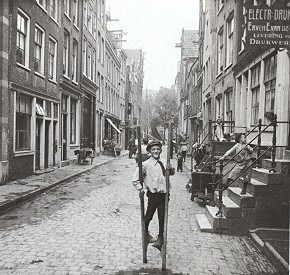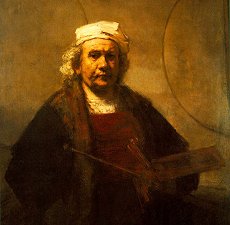 |
|
The Amsterdam Jordaan
 |
|
![]()
The constructionThe Jordaan, firstly called 'het nieuwe Werck' (the new work), was built in the seventeenth century for the poorer citizens and craftsmen. It was planned at the west side of the 'grachtengordel' (main canals), which was built for the rich businessmen. Because the street pattern was based on old ditches and paths, it differs entirely of the rest of the old city centre; the streets and canals do not lock up with the 'grachtengordel' which was build at the same time. Surrounding the Jordaan they constructed a new town rampart, for protection against a siege. |
|
|||
The golden ageThe Jordaan was in the first century of its existence an attractive neighborhood, where intellectuals and craftsmen lived and worked side by side. The V.O.C.made sure there was a ongoing need for craftsmen and sailors from districts like the Jordaan. |
|
|||
Rembrandt van RijnOne of the most famous inhabitants of the Jordaan ever, is without any doubt Rembrandt van Rijn. In the period that Rembrandt lived in the Jordaan, it was a poor district for the working class. So it is clear it was in Rembrandt's lesser successful periodswhen he lived in this neighborhood. For financial reasons he had to sell his stately traders house in the Jodenbreestraat, to settle with a small rental house at the Rozengracht (what still was a real canal at that time). |
 |
|||
The impoverishmentThe population increase in the 19th century was enormously, as a result of which the life conditions in the Jordaan deteriorated drastically. Around 1900 there lived about 78,000 people (now 19.000). The neighborhood existed of half houses, slums, alleys and some canals which served for both transport and as sewer. A large part of the houses become dilapidated very fast. The City Council did hardly anything, they rather let the neighborhood languish, to reorganize it in one large strike. Meanwhile the people with a fair income were encouraged to move to another part of the town. |
|
|||
During the second world warOn the Noordermarkt on Monday 24 February 1941 the 'February strike' was exclaimed. About 250 man gathered, whereupon the strike spread around in the whole city. When the next day everyone in the city had laid down their work, they all came to the Noordermarkt. There they where suppressed hard by the police (the German 'Ordnungspolizei'). |
|
|||
The revivalAfter the second world war the city counsel developed several (never implemented) plans to reorganize the neighborhood. They had serious plans to mainly demolish big parts of the district and replaced them for large blocks of houses. There where many protests against this idea. City protectors, such as monument care, were against the loss of the historical town and the people of the Jordaan themselves feared for large rent increases. Thanks to this resistance the plan was modified. There came small-scale projects which would repair the neighborhood, without damaging it's original character. |
|
|||
Streaming powered by Unreal Media Server